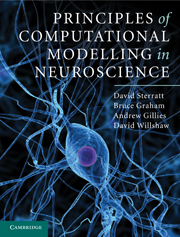Book contents
- Frontmatter
- Contents
- List of abbreviations
- Preface
- Acknowledgements
- Chapter 1 Introduction
- Chapter 2 The basis of electrical activity in the neuron
- Chapter 3 The Hodgkin–Huxley model of the action potential
- Chapter 4 Compartmental models
- Chapter 5 Models of active ion channels
- Chapter 6 Intracellular mechanisms
- Chapter 7 The synapse
- Chapter 8 Simplified models of neurons
- Chapter 9 Networks of neurons
- Chapter 10 The development of the nervous system
- Chapter 11 Farewell
- Appendix A Resources
- Appendix B Mathematical methods
- References
- Index
Chapter 2 - The basis of electrical activity in the neuron
Published online by Cambridge University Press: 05 June 2012
- Frontmatter
- Contents
- List of abbreviations
- Preface
- Acknowledgements
- Chapter 1 Introduction
- Chapter 2 The basis of electrical activity in the neuron
- Chapter 3 The Hodgkin–Huxley model of the action potential
- Chapter 4 Compartmental models
- Chapter 5 Models of active ion channels
- Chapter 6 Intracellular mechanisms
- Chapter 7 The synapse
- Chapter 8 Simplified models of neurons
- Chapter 9 Networks of neurons
- Chapter 10 The development of the nervous system
- Chapter 11 Farewell
- Appendix A Resources
- Appendix B Mathematical methods
- References
- Index
Summary
The purpose of this chapter is to introduce the physical principles underlying models of the electrical activity of neurons. Starting with the neuronal cell membrane, we explore how its permeability to different ions and the maintenance by ionic pumps of concentration gradients across the membrane underpin the resting membrane potential. We show how the electrical activity of a small neuron can be represented by equivalent electrical circuits, and discuss the insights this approach gives into the time–dependent aspects of the membrane potential, as well as its limitations. It is shown that spatially extended neurons can be modelled approximately by joining together multiple compartments, each of which contains an equivalent electrical circuit. To model neurons with uniform properties, the cable equation is introduced. This gives insights into how the membrane potential varies over the spatial extent of a neuron.
A nerve cell, or neuron, can be studied at many different levels of analysis, but much of the computational modelling work in neuroscience is at the level of the electrical properties of neurons. In neurons, as in other cells, a measurement of the voltage across the membrane using an intracellular electrode (Figure 2.1) shows that there is an electrical potential difference across the cell membrane, called the membrane potential. In neurons the membrane potential is used to transmit and integrate signals, sometimes over large distances. The resting membrane potential is typically around –65mV, meaning that the potential inside the cell is more negative than that outside.
- Type
- Chapter
- Information
- Principles of Computational Modelling in Neuroscience , pp. 13 - 46Publisher: Cambridge University PressPrint publication year: 2011



